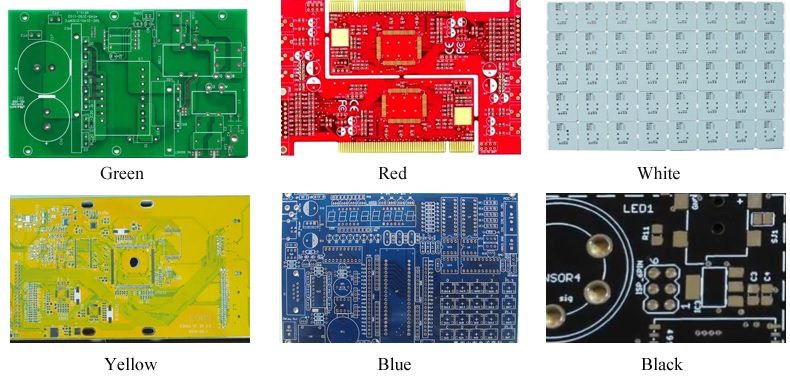When it comes to PCB design, one question often pops up: what do solder mask colors mean, and how do they impact your project? Simply put, solder mask colors are the protective layers applied to printed circuit boards (PCBs) to shield copper traces from damage and prevent short circuits. While the color itself doesn’t affect performance, it plays a role in aesthetics, inspection ease, and branding. In this ultimate guide, we’ll dive deep into solder mask color meanings, provide a detailed PCB color guide, explain solder resist colors, explore PCB design aesthetics, and offer tips for solder mask color selection. Let’s break it down step by step to help you make informed choices for your next design.
What Is a Solder Mask and Why Does Color Matter?
A solder mask, also known as solder resist, is a thin polymer layer applied to the copper traces of a PCB. Its primary job is to protect the board from oxidation, prevent solder mask bridges during assembly, and insulate against electrical shorts. Without this layer, your PCB would be vulnerable to environmental damage and manufacturing errors.
Now, let’s talk about color. The solder mask is what gives a PCB its distinct look—whether it’s the classic green, a sleek black, or a vibrant red. While the color doesn’t change the board’s electrical performance, it can influence several practical aspects:
- Inspection and Visibility: Certain colors make it easier to spot defects during quality checks.
- Aesthetics and Branding: Color can reflect a product’s identity or target market.
- Cost and Availability: Some colors are more common and cheaper to produce than others.
In the following sections, we’ll unpack the meaning behind solder resist colors and guide you through selecting the right one for your PCB design.

Common Solder Mask Colors and Their Meanings
Understanding the meaning behind solder mask colors can help you choose the best option for your project. While there’s no universal standard dictating what each color “means,” industry practices and perceptions have shaped their use. Let’s explore the most common colors and their typical associations in PCB design.
1. Green - The Industry Standard
Green is the most widely used solder mask color and has been the default for decades. Its popularity stems from historical reasons—early solder mask formulas were green due to the materials used, and manufacturers stuck with it. Today, green remains the go-to choice for several reasons:
- High Contrast: It provides excellent contrast against white silkscreen text and copper traces, making inspection easier under bright lights.
- Cost-Effective: Green solder mask ink is widely available and often the cheapest option.
- Reliability: Its long history means the formula is well-tested for durability and performance.
Green is ideal for most general-purpose PCBs where cost and visibility are priorities.
2. Blue - Modern and Professional
Blue solder masks are often associated with a clean, modern look. They’re popular in consumer electronics and products where aesthetics matter. Key characteristics include:
- Moderate Contrast: Blue offers decent visibility for inspection, though not as sharp as green.
- Branding Appeal: It’s often used by companies wanting a tech-savvy or premium appearance.
- Slightly Higher Cost: Blue is less common than green, so it may cost a bit more.
3. Red - Bold and Eye-Catching
Red solder masks stand out and are frequently used for high-end or custom designs. They’re less common in mass production due to cost but have distinct advantages:
- Strong Branding: Red often signals a premium or specialized product.
- Lower Contrast: It can be harder to inspect under certain lighting, so it’s not ideal for complex boards.
- Unique Aesthetic: Perfect for products where visual impact is key.
4. Black - Sleek and Sophisticated
Black solder masks are often chosen for luxury electronics or designs where a minimalist look is desired. However, they come with trade-offs:
- Poor Visibility: Black absorbs light, making it tough to spot defects or read silkscreen text.
- Heat Absorption: It can retain more heat, which might affect performance in high-temperature environments.
- Premium Look: Often used in high-end audio equipment or gaming hardware.
5. White - Clean and Minimalist
White solder masks are rare but used in specific applications like LED boards where light reflection is important. Considerations include:
- Reflectivity: White enhances light output, ideal for lighting designs.
- Difficult Inspection: It’s prone to showing dirt and offers low contrast for text.
- Specialized Use: Not suitable for most standard PCBs due to maintenance challenges.

PCB Color Guide: Factors to Consider in Solder Mask Color Selection
Choosing the right solder mask color for your PCB design isn’t just about looks. Several practical factors come into play. This PCB color guide will walk you through the key considerations to ensure your choice aligns with your project’s needs.
1. Visibility for Inspection
During manufacturing and quality control, inspectors need to clearly see traces, vias, and potential defects. Colors like green and blue offer high contrast with copper and silkscreen, making them ideal for detailed boards. Darker colors like black or red can hide flaws, leading to missed errors. If your design has tight tolerances—say, trace widths below 0.1 mm—opt for a high-contrast color to ensure accuracy during checks.
2. Application Environment
Think about where your PCB will be used. For example, if it’s part of an outdoor device exposed to sunlight, a black solder mask might absorb too much heat, raising the board’s temperature by up to 10-15°C compared to lighter colors. On the other hand, white masks reflect heat and light, which is beneficial for LED applications where efficiency matters.
Suggested Reading: Solder Mask Application: Best Practices for Durability
3. Cost and Availability
Green solder masks are the most cost-effective, often priced 10-20% lower than specialty colors like purple or yellow due to economies of scale. If you’re working on a tight budget or need fast production, sticking with green can save time and money. Custom colors might also require longer lead times since they’re not always in stock.
4. PCB Design Aesthetics and Branding
In consumer-facing products, PCB design aesthetics can make a big difference. A red or blue solder mask can reinforce brand identity, especially if the board is visible through a transparent casing. For instance, gaming hardware often uses bold colors like red to convey power and speed, while medical devices might use blue for a calming, professional vibe.
5. Assembly and Repair Considerations
During PCB assembly, technicians rely on color contrast to place components accurately. A low-contrast color like black might slow down manual soldering processes, increasing error rates by as much as 5-10% in poorly lit conditions. Similarly, for repairs, a high-contrast mask makes it easier to trace circuits and identify issues.

Solder Resist Colors Explained: Do They Impact Performance?
One common misconception is that solder resist colors affect a PCB’s electrical performance. Let’s set the record straight: the color of the solder mask has no direct impact on impedance, signal speed, or thermal conductivity. The material composition of the mask—typically an epoxy-based polymer—determines its protective qualities, not the pigment.
For example, whether you choose green or black, the dielectric constant of the solder mask remains roughly the same, around 3.3 to 4.0 at 1 MHz, ensuring consistent insulation. Signal integrity, often a concern for high-frequency designs operating above 1 GHz, depends more on substrate materials like FR-4 (with a dielectric constant of 4.5) than on the mask color.
However, indirect effects can occur. As mentioned earlier, black masks absorb more heat, potentially raising the board’s operating temperature. In a high-power application dissipating 5W or more, this could push components beyond their thermal limits if not managed with proper heat sinks. So, while color doesn’t change the mask’s core properties, it can influence environmental factors.
Tips for Solder Mask Color Selection in PCB Design
Selecting the right solder mask color doesn’t have to be complicated. Here are some practical tips to guide your decision-making process and ensure your PCB design meets both functional and aesthetic goals.
1. Start with Functionality
Prioritize the practical needs of your project. If you’re designing a complex board with fine-pitch components (e.g., 0.5 mm spacing), choose a high-contrast color like green for easier inspection. If the board will be exposed to high temperatures, avoid dark colors that trap heat.
2. Align with Branding Goals
If your PCB will be visible to end users, consider how the color reflects your product’s identity. A vibrant red might suit a gaming console, while a clean blue could fit a smart home device. Consistency with your brand’s color palette can enhance recognition.
3. Test Under Lighting Conditions
Before finalizing a color, prototype your design and inspect it under the lighting conditions used during assembly. Some colors, like yellow, may look appealing but offer poor contrast under fluorescent lights, leading to assembly errors.
4. Budget for Custom Colors
If you’re opting for a non-standard color, account for potential cost increases. Specialty inks can add 15-30% to production costs, and minimum order quantities might apply. Weigh the visual benefits against the added expense.
5. Consult with Your Manufacturer
Finally, check with your PCB manufacturer about available colors and their recommendations. They can provide insights into which colors perform best under their manufacturing processes and might offer samples to help you decide.
Future Trends in Solder Mask Colors and PCB Design Aesthetics
As technology evolves, so do trends in PCB design aesthetics and solder mask colors. Manufacturers are increasingly offering a wider range of colors, including matte finishes and even transparent masks for unique visual effects. Matte green or matte black, for instance, reduces glare during inspection while maintaining a premium look.
Another emerging trend is the use of dual-tone masks, where different areas of the board feature contrasting colors for both functional and aesthetic purposes. This can help highlight critical zones, like power sections, during troubleshooting. Additionally, eco-friendly solder mask materials are gaining traction, with some pigments now derived from sustainable sources without compromising durability.
In terms of aesthetics, expect more customization as additive manufacturing techniques improve. Imagine PCBs with gradient colors or patterns integrated into the solder mask—options that could redefine product design in consumer electronics over the next decade.
Conclusion: Making the Right Choice for Your PCB Design
Decoding solder mask colors is about balancing functionality, cost, and aesthetics in your PCB design. Whether you stick with the classic green for its reliability and visibility or opt for a bold red to stand out, each color has its place in the world of electronics. By understanding solder mask color meanings, following a practical PCB color guide, and considering factors like inspection ease and branding, you can make a choice that enhances both performance and appeal.
Remember, the right solder mask color isn’t just a cosmetic decision—it’s a strategic one. Take the time to evaluate your project’s specific needs, from environmental conditions to assembly requirements, and you’ll create a PCB that’s as functional as it is visually striking. With this ultimate guide, you’re equipped to navigate the colorful world of solder resist and elevate your next design.
 ALLPCB
ALLPCB







